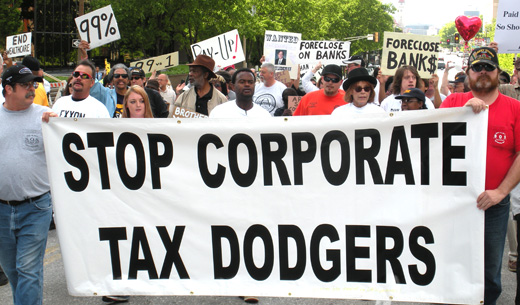
WASHINGTON (PAI) — When Boeing put its Puget Sound production line up for bid late last year, in a wrangle with the Machinists over a contract extension, Washington State jumped in with an $8.7 billion tax break package to keep the planes in the Pacific Northwest. And under pressure from state officials and international union leaders, local workers narrowly and bitterly agreed to the extension – one that wipes out traditional pensions for new hires and freezes them for current workers. Now Washington taxpayers are stuck with the bill.
Washington’s kowtowing to Boeing is no great surprise. States and cities frequently shower firms with millions of dollars in tax breaks, all in the name of gaining – or keeping – jobs. Now Good Jobs First, in a new analysis on its Subsidy Tracker, shows Boeing is typical of such political largesse: The corporate rich get richer from it.
Meanwhile, workers and small businesses get the crumbs.
The non-profit, non-partisan think tank has compiled taxpayer subsidies – property tax abatements, worker training rebates, new infrastructure, tax-exempt financing, etc. – for years. Refining its database, it reports that 75 percent of the $110 billion in subsidies it recorded starting in the 1990s went to companies in the Fortune 500, like Boeing, and their privately held equivalents, as measured by Forbes and other sources.
“A dominant share of the subsidies by state and local governments in the name of job creation is ending up in the hands of a limited group of companies which can be regarded as the corporate 1 percent,” said Good Jobs First Research Director Philip Mattera.
Boeing led the entire subsidy list, helped by that $8.7 billion from Washington and another $1 billion from South Carolina to locate its 787 Dreamliner assembly line in the Palmetto State. States and cities forked over a total of $13 billion to Boeing.
Boeing sent 787 production southwards after workers at Boeing’s North Charleston, S.C., plant voted the Machinists out – and after the company CEO specifically said the firm would transfer production to the Palmetto State to punish the Machinists for standing up for their members in the Pacific Northwest. That triggered a long controversy with the National Labor Relations Board, which found Boeing illegally retaliated against IAM via the transfer. The controversy was settled later.
Smaller state sums to Boeing included an $8.37 million tax credit to its McDonnell-Douglas subsidiary in St. Louis, and three grants and low-cost loans, totaling $6.25 million, from Chicago in 2010 to convince Boeing to move its headquarters.
Boeing’s bonanza equaled the sum the three runners-up in the corporate sweepstakes got, combined. Alcoa finished second, getting $5.6 billion in state and local taxpayer largesse, followed by Intel ($3.9 billion), General Motors ($3.5 billion) and Ford ($2.5 billion).
Seventeen companies got single-subsidy awards of at least $1 billion each, and that doesn’t include Boeing in North Charleston. It got one award there for $120 million, and a second one – for the Dreamliner assembly line – for $900 million.
Manufacturing firms dominate the top 10 in corporate subsidies from states and cities. Besides Boeing, the semiconductor firm Intel, GM and Ford, the others are Chrysler (now Fiat), Nissan, Shell, Dow Chemicals and the huge steel firm ArcelorMittal. Several corporate subsidy recipients are notable for other reasons:
Peabody Energy manipulated bankruptcy in order to escape its health care obligations to its United Mine Worker retirees. Kentucky gave it $266 million in subsidies and cities in Southern Illinois coal country added $12 million.
• Virtually all of the $869.75 million credited to red state, anti-union Delta Airlines actually went from Minnesota, a blue state, to Northwest Airlines, before Delta devoured wall-to-wall unionized Northwest. Management successfully pressured flight attendants at the “new Delta” to vote out the Association of Flight Attendants/CWA. Northwest won a 1991 $838 million Minnesota megadeal to keep key operations in Duluth and Hibbing.
• Chrysler’s $2.06 billion in corporate largesse is just from state and local governments, not from the federal loan guarantee and bankruptcy restructuring the Bush and Obama administrations used to help Chrysler (Fiat) and GM revive from the 2008 crash. Most of the Chrysler money was a $1.3 billion tax credit/rebate from the city of Sterling Heights and the state of Michigan. Another $232 million was a 1997 Ohio subsidy to the Jeep plant in Toledo.
• Almost 60 percent of GM’s $3.49 billion came from Michigan and its communities. But Missouri and Kansas chipped in another $764 million combined and almost half of that sum was in the Kansas City area. GM also got more than 300 separate subsidies of various sizes and descriptions from around the country, down to $8 million in property tax abatements over several years from Shreveport, La., and $132 million in Ohio subsidies for the firm’s troubled plant in Lordstown.
Ford didn’t take federal loan guarantees, but it took the state aid. Three-fourths of its $2.5 billion over the years came from Michigan and its cities and suburbs. Ford also got $240 million from Kentucky for the Louisville factory and $100 million in tax financing, low-cost loans and other subsidies for its Chicago plant.
Photo: Tax day rally in Chicago. PW Flickr.












Comments